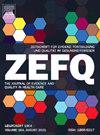[将持有学位的护理专业人员纳入德国大学医院:2018年和2024年调查结果的比较]。
IF 1.7
Q4 HEALTH POLICY & SERVICES
Zeitschrift fur Evidenz Fortbildung und Qualitaet im Gesundheitswesen
Pub Date : 2025-09-01
DOI:10.1016/j.zefq.2025.07.001
引用次数: 0
摘要
简介:德国的医疗保健面临着重大挑战,需要更多的学术合格的护理专业人员的参与。尽管护理专业的学院化有积极的趋势,但挑战仍然存在,需要进一步系统的研究。方法:通过调查收集德国大学医学中心和大学医院拥有大学学位的护理专业人员数量和比例的当前定量数据,并将这些数据与2018年的结果进行比较。此外,我们还调查了这些专业人员从事直接病人护理工作的比例、现有护理科学机构、工作描述和学术护理专业人员的激励措施。结果:分析包括来自14所大学医学中心和大学医院的数据,这些数据提供了2024年和2018年的完整数据集。护理专业人员中具有大学学历的比例从2018年的2.92 %上升到2024年的3.91 %。在患者直接护理中,比例从2.14% %上升到3.18% %。在二零二四年,从事直接病人护理的大学学位护理专业人员占直接病人护理服务的雇员总数的比例为3.50 %。具有大学学位的护理专业人员的工作描述、薪酬水平分组和非金钱激励方面存在相当大的异质性。在所包括的诊所中,有四家拥有护理科学研究所,三家拥有护理科学主席,两家拥有护理学的初级资格学位课程。讨论:调查结果显示,德国大学医院在整合学术上合格的护理专业人员方面取得了进展,但挑战仍然存在。3.18 %,学术上合格的护理专业人员在直接病人护理中的比例仍然远低于建议的20% %。该研究强调了明确的职位描述、集体薪酬标准分组和激励措施的重要性,以更好地整合这些专业人员在医疗保健系统中的角色,充分利用他们的能力。本文章由计算机程序翻译,如有差异,请以英文原文为准。
Einbindung von Pflegefachpersonen mit Hochschulabschlüssen an deutschen Universitätskliniken: Vergleich der Befragungsergebnisse 2018 und 2024
Introduction
Healthcare in Germany faces major challenges that require greater involvement of academically qualified nursing professionals. Despite positive trends in the academization of the nursing profession, challenges remain that require further systematic research.
Methods
A survey was used to collect current quantitative data on the number and proportion of nursing professionals with a university degree at German university medical centers and university hospitals and to compare these data with the results from 2018. In addition, we investigated the proportion of these professionals with positions in direct patient care, existing institutes for nursing science, job descriptions, and incentive measures for academic nursing professionals.
Results
The analysis comprises data from 14 university medical centers and university hospitals that provided complete data sets for 2024 and 2018. The proportion of nursing professionals with a university degree increased from 2.92 % in 2018 to 3.91 % in 2024. In direct patient care, the proportion rose from 2.14 % to 3.18 %. The proportion of nursing professionals with a university degree in direct patient care in relation to the total number of employees in nursing services in direct patient care was 3.50 % in 2024. There was considerable heterogeneity in terms of job descriptions for nursing professionals with a university degree, pay-scale grouping, and non-monetary incentives. Of the clinics included, four had an Institute of Nursing Science, three had a chair in Nursing Science, and two had a primary qualifying academic degree program in nursing.
Discussion
The survey results show progress towards the integration of academically qualified nursing professionals in German university hospitals, but challenges remain. At 3.18 %, the proportion of academically qualified nursing professionals in direct patient care remains well below the recommended 20 %. The study emphasizes the importance of clear job descriptions, collective pay-scale groupings, and incentives to better integrate the roles of these professionals in the healthcare system and make full use of their abilities.
求助全文
通过发布文献求助,成功后即可免费获取论文全文。
去求助
来源期刊

Zeitschrift fur Evidenz Fortbildung und Qualitaet im Gesundheitswesen
HEALTH POLICY & SERVICES-
CiteScore
1.90
自引率
18.20%
发文量
129
 求助内容:
求助内容: 应助结果提醒方式:
应助结果提醒方式:


